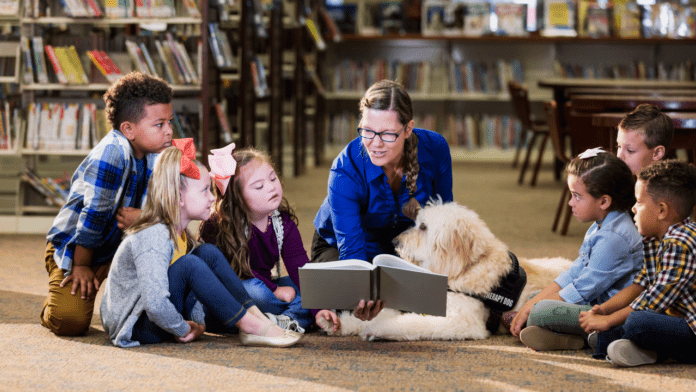Today is World Autism Day. Whether you stand for Awareness or Acceptance, the goal is still inclusivity. But we’re going to be talking broader than Autism. We are going to be touching on disabilities as a whole. According to the CDC, a disability is any condition of the body or mind (impairment) that makes it more difficult for the person with the condition to do certain activities (activity limitation) and interact with the world around them (participation restrictions).
When you enter a public space and look around, is there ever anyone that looks or acts EXACTLY like you? Most likely not. Now, that isn’t to say that a lot of people in that space aren’t similar to you. They likely are. But if you look close, you may find subtle and not so subtle signs that someone in your midst is disabled.
Let’s paint that picture.
You walk into the public library. There is a library clerk standing at the desk as you walk in. You greet her with a quiet hello and a wave. She smiles and waves back. As she turns to work with the next patron who is approaching, you notice that she has a hearing aid. That next patron also smiles at you. She is holding the hand of a young child who is carrying what looks to be an iPad. The child and parent are wearing wrist cuffs that are connected by a long coil. The child is also making some grunting and screeching sounds and their hands and arms are waving around. They are clearly excited about something.
As you walk further into the library, you can still hear the sounds of child checking out with their parent. You are looking for the fiction section, so you can browse for a nice book to take on vacation. During your search, you encounter a gentleman in the 600 section struggling to reach the book he needs because it’s on a shelf higher than his wheelchair will allow him to reach. You’re not sure you should get involved, but there is no one else around. You approach him to offer help. He accepts and apologizes for inconveniencing you. You move on to the fiction section, find a book, and head back to the front to check out. You smile again and adjust your glasses as you approach the library clerk. She smiles back and asks if you found everything you needed.
1. It’s Okay to be Different
So let’s break this down based on the picture that was just painted. You encountered multiple people that require accommodations to access the world around them. The library is deaf or hard of hearing, so she uses a hearing aid. The child you encountered is likely autistic. The iPad they was carrying is actually an AAC (Augmentative and Alternative Communication) device. You noted that they seemed excited. Their hand movements were actually stims. You were right, they were excited. They love the library and when their mom reads books to them. Sometimes they get some excited or overwhelmed, they elope. That’s why their mom uses a wrist tether. It’s not because the child is bad, or she is a bad mother. Her ultimate goal is always her child’s safety.
The gentleman that you encountered in the nonfiction section uses a wheelchair to help him gain access to the world at large. Unfortunately, you also witnessed how the world isn’t completely accessible to him. But there was one more person that was using an accommodation to access the world…You!
Your glasses are just as much of an accommodation as the hearing aid, the AAC device, the wrist tether, or the wheelchair. The difference is that glasses have been normalized to the point that we no longer view them as an accommodation. Also, the need for glasses as an accommodation doesn’t necessarily mean you are disabled.
Regardless, the point is that we all view and access the world differently. We all have different life experiences that make us who we are. Our differences are what make the world a more beautiful and interesting place.
2. Asking Questions is Okay (and Preferred!)
It is time to move past the “don’t stare at them!” era. This mindset teaches our children to look past those with disabilities to the point that they become invisible- To pay no attention to them. Rarely does this behavior transfer to the mindset of treating disabled folks on a level playing field. It looks more like this: “I don’t acknowledge people that are different from me.”
If you happen to be in a public setting where your child notices a person with a disability, acknowledge that they are curious: “I see you’ve noticed our friend using braces/crutches/a wheelchair,” or “Are you looking at the individual using headphones or a speaking device?” Explaining the use of items that allow disabled folks to access the same spaces that able bodied, neurotypical people. Ask your child what they know about the use of those devices or modes of mobility- kids often answer honestly and at the level of understanding they are willing to accept.
Oftentimes caregivers, and (sometimes) the disabled person are willing to answer questions in a low risk, calm environment. Especially if you see that your child is staring or asking questions, ask if they would like to say hi! Remember that young children are going to ask questions in a blunt manner because that is developmentally appropriate for them. You can help your child clarify what they are asking, but also help them point out similarities between themselves and the disabled person: “Yes, they are using headphones because the noise level in the food court is too loud, but I see you both like watching YouTube!”
3. We’re More Alike Than Different
You may or may not have heard of Maslow’s hierarchy of needs! Basically, an American psychologist by the name of Abraham Maslow developed a theory to explain human motivation. This theory basically states that before you can have your higher needs met, your basic needs need to be met first.
So why is that important for teaching inclusivity?
Well, whether you are neurotypical or neurodivergent, have full physical abilities or need the use of assistance for mobility, are gifted, intellectually disabled, or of average intelligence, your basic needs are the same. We all need our physiological needs met: food, water, air, shelter, sleep, and clothing. We all benefit from feeling safe and secure: safe at home or in public, safe to share our emotions, having financial security, our health, etc. We all want to feel love and a sense of belonging.
We all have these needs, regardless of what our body or mind is capable of doing. Using these needs to create a common ground for your child to relate to others is a great way for them to connect to anyone, not just those with disabilities.
4. Educating Your Children About Disabilities Begins With Educating Yourself
So what happens if you, the adult and the parent, don’t know much about how disabled folks access the world around them? That would indicate that now is a good time for self reflection: how much exposure do you have to being around disabled individuals, what is your perception of disabled people (and their caregivers), what more could you learn about the barriers that disabled people face in a world that is not designed for them? Our ability as non-disabled, neurotypical parents will affect the way that we explain disabilities to our children. Our children’s kindness and respect towards others starts with us.
5. Introducing Inclusive Media
A really easy way to initiate organic conversations with your children about disabled folks is by using media that is inclusive. This approach normalizes disabled people in a public setting, and prepares you for the level of questions they may ask about modes of mobility, speaking devices, stimming, and general levels of support that disabled people may require to access the world around them. We have complied a list with links below for you!
- You Are Enough: A Book About Inclusion (Down Syndrome inclusion and awareness)
- Everyone Belongs ( a fun rhyming book about general acceptance)
- A Day With No Words (Autism and non-speaking communication)
- We’re Different, We’re the Same (identifying differences and similarities in all individuals)
- Louie’s Together Playground (genetic conditions and accessible playgrounds for all bodies)
- Too Much! An Overwhelming Day (sensory processing disorders)
- Awesome Ollie (utilizing medical equipment to meet basic needs)
- The Laurie Berkner Band YouTube Channel (songs and dances for all bodies!)
It’s Time to Get Uncomfortable
Learning new information can sometimes be uncomfortable. Especially when it comes to learning about accessing the world through the body of a disabled person or the caregiver that is responsible for them. Many of us in the caregiver role experienced these same growing pains as you may have experienced reading this article. Discomfort is necessary for growth. Even though our journeys as parents may look different, our responsibilities remain the same: we are responsible for teaching our children about the world around them, both directly and indirectly. The indirect teaching we do is just as important- what we say about others and how we treat them speaks volumes to our children. So, get uncomfortable. Get uncomfortable with the questions your children will likely ask about the world around them, get uncomfortable in learning about different experiences others have, get uncomfortable in knowing people who are different from you.











